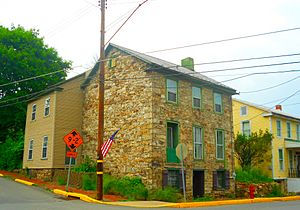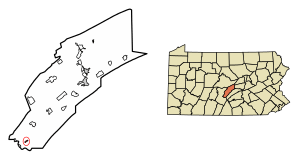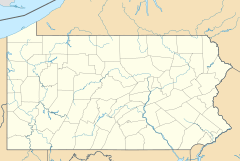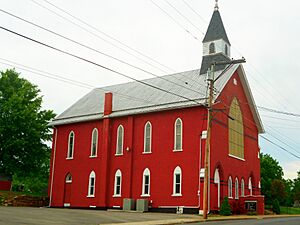Newton Hamilton, Pennsylvania facts for kids
Quick facts for kids
Newton Hamilton, Pennsylvania
|
|
|---|---|
|
Borough
|
|

House on Water Street
|
|

Location of Newton Hamilton in Mifflin County, Pennsylvania.
|
|
| Country | United States |
| State | Pennsylvania |
| County | Mifflin |
| Settled | 1802 |
| Incorporated | 1843 |
| Government | |
| • Type | Borough Council |
| Area | |
| • Total | 0.18 sq mi (0.48 km2) |
| • Land | 0.15 sq mi (0.40 km2) |
| • Water | 0.03 sq mi (0.08 km2) |
| Population
(2020)
|
|
| • Total | 196 |
| • Density | 1,264.52/sq mi (488.48/km2) |
| Time zone | UTC-5 (Eastern (EST)) |
| • Summer (DST) | UTC-4 (EDT) |
| Zip code |
17075
|
| Area code(s) | 814 |
| FIPS code | 42-54160 |
| Local phone exchanges: 542, 543 | |
Newton Hamilton is a small town, called a borough, located in Mifflin County, Pennsylvania, United States. It became an official borough on April 12, 1843. In 2020, about 197 people lived there.
Contents
History of Newton Hamilton
Early Beginnings: Land and First Settlers
The story of Newton Hamilton began on June 15, 1762. A man named Hugh Brown received permission to own about 250 acres of land. This land later became the borough of Newton Hamilton. Sadly, Hugh Brown died before 1783. His land was then passed down to Margaret Hamilton.
In 1783, Margaret Hamilton owned about 60 acres of land. She started selling parts of this land in 1802. On January 19, 1802, she sold two plots of land to Samuel McCurdy. These plots were 50 by 150 feet. They were located on what is now Front Street in the borough. Margaret Hamilton is known for planning out the town around 1802. She lived in Newton Hamilton until she passed away.
Growth and Development in the 1800s
More land sales happened in the early 1800s. On April 18, 1803, Margaret Hamilton sold two more plots to James Irvine. These plots were 60 by 130 feet each. They were located on what is now Second Street.
By 1826, Newton Hamilton was a small village. It had only seven log homes. These homes belonged to people like Acquilla Burchfield, John McGeehan, and John Murray. In 1828, Patrick and James Moffit bought land here. They lived in a house near a spring. Also in 1828, Elijah Davis opened a store.
The town grew more as surveyors planned new canal routes. These canals helped connect towns and move goods. In 1829, John Postlethwait opened a tavern, which later became known as the Logan House. Other stores, like Robert Thompson & Co., also opened.
Community Life and Occupations
By 1830, Newton Hamilton had a school. Samuel Cross taught there. The town continued to grow over the next few years. By 1836, many different workers lived in Newton Hamilton.
- Boat builder: Robert M. Davidson
- Carriage and wagon makers: John Coulter, Charles H. Knox, Joseph Laughlin, Benjamin Norton
- Carpenters: Lewis Barnard, Samuel A. Corbett, Jacob Hesser, Nathan Jones, William McAnear, Robert A. McDowell, Joseph and Samuel D. Postlethwait, Thomas J. Postlethwait Jr., Alfred Walker
- Saddlers (people who make saddles): Alexander Cumming, Thomas Galbraith, George Guss
- Shingle makers: Thomas Baird, William Harvey
- Tailors: Casper Bucher, Burr L. Buckley, Robert Witherow
- Teachers: James and Walter Galbraith, Winchester McCarthy, and William Uttley
In 1838, officials bought James Irvine's land. They built a new stone schoolhouse there.
Becoming an Independent Borough
From 1840 to 1884, John Morrison was the town's justice of the peace. He had moved to Newton Hamilton in 1829. During this time, in 1844, Newton Hamilton became an "independent district." This meant it separated from the larger township.
By 1845, the community had blacksmiths and boatmen. John Sigler ran a tannery, which processed animal hides. John Lowry and Riley J. Richards made cabinets. Merchants like John Bolsbach and James D. Morrison had businesses. Doctors A. J. Akinson and Charles Bower also practiced medicine here.
From 1850 to 1877, John Smelker opened another tannery. As the town grew, more visitors came. In 1867, John B. Miller built a hotel, which later became the Everett House. Around this time, a new bridge was built over the river. A flood destroyed it in 1880, but it was rebuilt by 1881. The new bridge cost $14,895.
Geography of Newton Hamilton
Newton Hamilton is located in Pennsylvania. Its exact coordinates are 40°23′34″N 77°50′6″W / 40.39278°N 77.83500°W.
The United States Census Bureau says the borough covers about 0.2 square miles (0.48 square kilometers). Most of this area is land, but about 0.04 square miles (0.08 square kilometers) is water.
Population of Newton Hamilton
| Historical population | |||
|---|---|---|---|
| Census | Pop. | %± | |
| 1850 | 353 | — | |
| 1860 | 306 | −13.3% | |
| 1870 | 350 | 14.4% | |
| 1880 | 317 | −9.4% | |
| 1890 | 333 | 5.0% | |
| 1900 | 384 | 15.3% | |
| 1910 | 340 | −11.5% | |
| 1920 | 400 | 17.6% | |
| 1930 | 348 | −13.0% | |
| 1940 | 395 | 13.5% | |
| 1950 | 397 | 0.5% | |
| 1960 | 338 | −14.9% | |
| 1970 | 280 | −17.2% | |
| 1980 | 317 | 13.2% | |
| 1990 | 287 | −9.5% | |
| 2000 | 272 | −5.2% | |
| 2010 | 205 | −24.6% | |
| 2020 | 197 | −3.9% | |
| 2021 (est.) | 196 | −4.4% | |
| Sources: | |||
In 2000, there were 272 people living in Newton Hamilton. These people lived in 99 households, and 79 of these were families.
The population density was about 1,624 people per square mile. There were 114 housing units in the borough.
About 43.4% of households had children under 18 living with them. Most households (60.6%) were married couples. About 18.2% of all households were single individuals. About 11.1% of households had someone aged 65 or older living alone.
The average household had 2.75 people. The average family had 3.04 people.
Looking at age groups in 2000:
- 30.5% were under 18 years old.
- 8.8% were between 18 and 24 years old.
- 27.6% were between 25 and 44 years old.
- 21.3% were between 45 and 64 years old.
- 11.8% were 65 years or older.
The average age in the borough was 32 years. For every 100 females, there were about 88.9 males.
See also
 In Spanish: Newton Hamilton para niños
In Spanish: Newton Hamilton para niños




